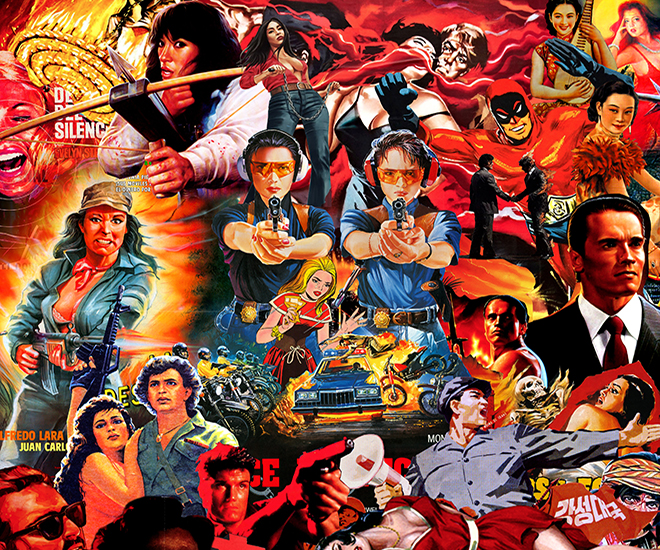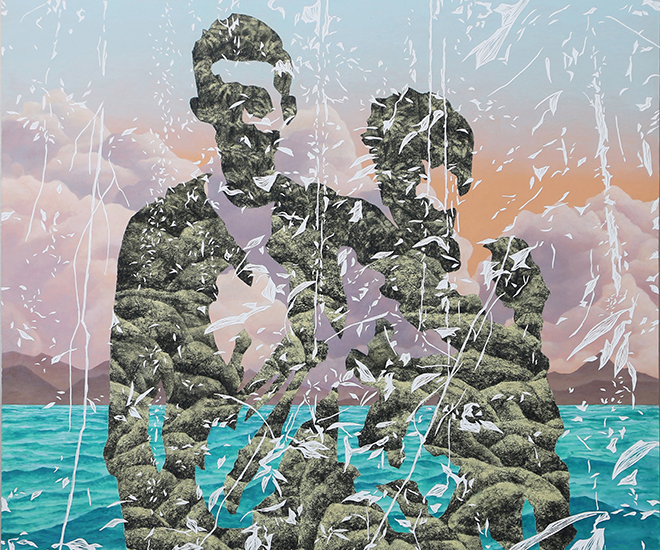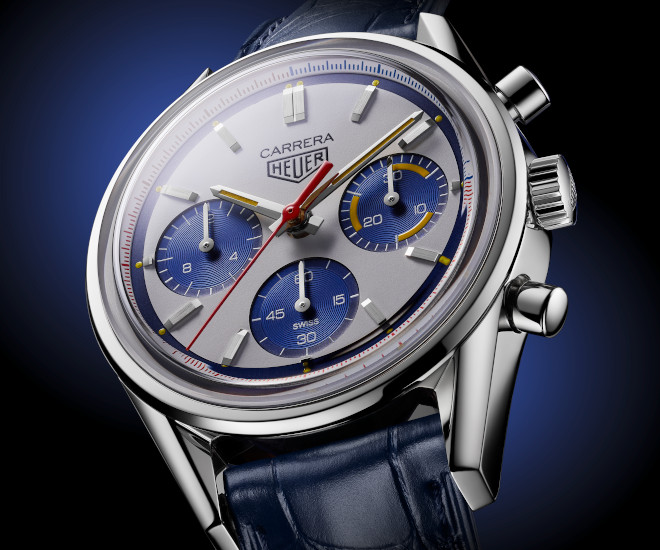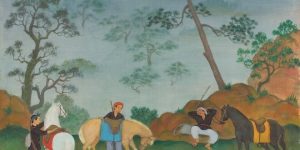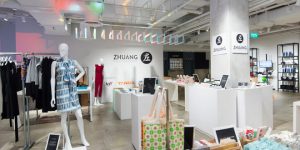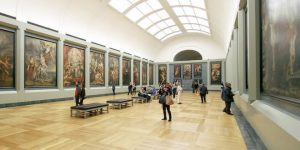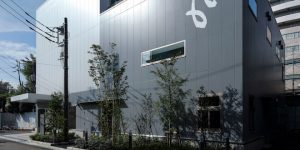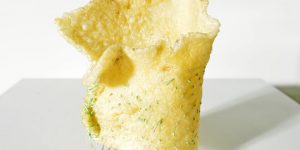Contemporary artists in Southeast Asia: Interview with Filipino painter and sculptor Ronald Ventura
Art Republik looks at darkness and light in the Shadow Forests of Ronald Ventura’s mind

Ronald Ventura, ‘Carousel’, 2016, fibreglass, resin, polyurethane paint, metal, mechanical and electrical device
“The main function of art… is to provide leads or cues for people to reflect more deeply and question,” asserts Ronald Ventura, in what could be read as a veiled punk stance, when discussing the power of art. Ventura is one of the most visible and prolific names in Filipino contemporary art right now, with an output both eclectic and undeniably engaging that has captured the public’s (both locally and internationally) consciousness: his creation of a body of work that baits the imagination to explore histories, the indeterminate vagaries of nature and the capriciousness of postmodern culture.
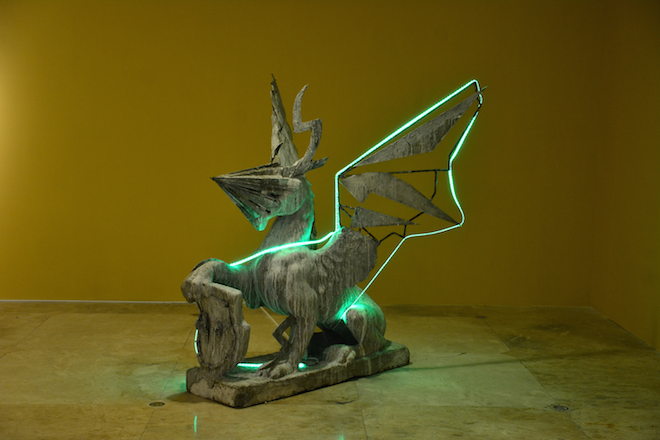
Ronald Ventura, Work from ‘Shadow Forest: Encounters and Explorations’
Littered in his universe, one finds bizarre unions of humans, unicorns, animals, angels, toys, skulls, pop culture paraphernalia as well as Christian and pagan iconography. Ventura melds them together, extracting new meaning in their amalgamation — as he intends, a “new grotesque reality” — to appall and enthrall, “just as Saint Anthony was enraptured by visions from Hell”, as he has been described. Part of the impulses driving Ventura’s visions/creations are in a sense parallel to Pinocchio (a recurring motif in his work), and his desire to become real.
Ventura’s paintings and sculptures — the strange love child of parodies and juxtaposed dualities are, at its vanishing point — inexorable actualisations of the the dissonance with ourselves and the uncertainty of the history and culture as we know it. They present an insight into our collective minds; flickering between the placid surface of our realities and the wild lands of fantasy.

Ronald Ventura, ‘Humanime 2’, 2011, fibreglass, resin, steel, polyurethane paint, 70.5 x 30.7 x 29.9 inches
Since 2010, Ventura has exhibited in Europe, New York and across Asia. In April 2011, in what is now the current record for the highest bid ever garnered at a contemporary Southeast Asian painting auction, Ventura’s ‘Greyhound’ broke the ceiling for the region when it sold for US$1.1 million at a Sotheby’s auction.
Following his most recent blockbuster exhibition ‘Shadow Forest: Encounters and Explorations’ at the Metropolitan Museum of Manila (MET) from January 30 to March 4, 2017 — the most comprehensive solo exhibition of his oeuvre to date (in conjunction with the museum’s 40th Anniversary) with works from his lithograph prints in the 1990s to his life-size mechanical carousels in 2016 — Art Republik sits down with Mr. Ventura himself, to pick his brain about pop style, modern living and the mystical.

Ronald Ventura, ‘Humanime 1’, 2011, fibreglass, resin, steel, polyurethane paint, 71.7 x 32.3 x 32.3 inches
You have often been described as “relentless” (image-maker), most recently by art historian, critic (and the curator of your major show at the MET) Patrick Flores. What is it about your drive? Is part of it informed by living in the vibrancy of a dynamic and effervescent city like Manila? Also, a lot of your work represents a globalised frame of mind, while remaining distinctively local. What are your thoughts on that and is the Philippines a perfect crossroads for this exact conversation?
You can say that my works represent a globalised frame of mind as I freely appropriate and mix elements across different cultures and sources. Some local elements are visible in my art but not really as a proactive assertion of my identity as Filipino.
Growing up in the Philippines was influential because it was the environment where my formative years as an artist was spent, but the time I spent outside was equally as important in shaping my artistic practice and perspective. I believe an artist should be able to transcend national boundaries and become citizens of the world.
It seems that mysticism and mythology — at least in the sense of its relationship with people — is a constant feature in your work… In the Philippines where folk spiritualism alongside religion is a huge part of people’s beliefs, do these symbols and ideas hold charged meanings for you, or is it more a meditation on people’s idea of “belief”?
I would say it is more of a meditation on people’s idea of belief. Imagery that appear to others as mythological and mystical are frequently incorporated in my works, but I may see them in a different light. For instance, certain forms in my artwork may be identified as sacred for the faithful of particular beliefs, but may be construed by others as something else. What I am trying to do in my art is to reflect on how we classify, categorise or label things, and ascribe value to them.

Ronald Ventura, Work from ‘Shadow Forest: Encounters and Explorations’
You have often married the mystical and a straight-up bright and cheery “plastic” pop; light and dark elements in your work; mixing classical forms with a pop art sensibility and so on. Is there something about dualities that interests you?
Pop and mystical, light and dark make sense when contrasted with one another. You can see in my recent works other dualities that I am exploring, such as between human and animal, between the natural and the man-made.
Mixing them in my works questions the very dichotomy or clear distinctions in people’s constructed perceptions. A classical figure might be seen as incongruous with pop imagery; someone might be surprised to see a human figure combined with animal features. In art, there should not be any boundaries. Art is the realm where these dualities can be transcended.
Your work often remind me of a Damien Hirst trope: “to shock you into living”. Is that something that you think about? Even though your approach is vastly different, and not chilling in a Francis Bacon sense, is spectacle something that you think about?
I don’t really intend my works to shock people and I’m not thinking about the element of spectacle. Maybe it’s just a coincidence that some people have that reaction, but what I am thinking is that I want my works to catch people’s attention. When you walk into a gallery, it is the work with the most impact that catches your attention, and that is what I take into consideration in creating my works. I’m thinking more of the impact, which can go beyond being shocking or spectacular.

Ronald Ventura, Works from ‘Shadow Forest: Encounters and Explorations’
Being from the Philippines, one can’t help but think it wouldn’t be possible to live there and not be politically entwined. Do politics play a part in your work? Your show ‘Fiesta Carnival’ in Milan sometime back, was a contemplation on transgression, borders, and the relationship between colony and coloniser, given Philippines’ history.
I think it is inevitable to have a political dimension emerge out of my works, After all, like you said, it is impossible not to be politically entwined. We live with it and have to deal with it. So sometimes I incorporate references or commentaries on political issues, though not necessarily subscribing or leaning towards a particular political agenda. It is just one way of reading and interpreting my artwork.
Is art something you’ve always wanted to do?
I remember I was already drawing even before I could master the alphabet. Creating art is something which I have been doing since my childhood. So I can say that my engagement with art goes way back when I was still a child.
Ronald Ventura, ‘Tree Bone’, 2015, fibreglass, resin, toner, silicon, 166 x 117 x 186 inches
It’s known that pop culture is one of the major things you’re interested in. How do you stay in the present moment? What are some of your preoccupations right now?
My interest in pop culture came at a time when my son was still a child. I wanted to spend time with my son, get to know him more. It so happened that he was fond of cartoon characters and the figures and toys of them. My preoccupation is not specifically pop culture but more on contemporary art, and since pop culture is part of contemporary art, it made its way into my works.
You are known for having a constantly evolving practice. From your surrealist earlier paintings, to more different mediums and thematics, much like the fantastical sculptural forms of late. How do you see yourself now, compared to when you first started out? Is it a constantly evolving dialogue, or pushing to the next levels the limits your idiosyncratic vernacular?
For me, that is the very nature of art, and much more for contemporary art. It is the way to stay in the moment, in the present. Since I started as an artist professionally, my art has explored various themes and I am constantly experimenting with media and subject.

Filipino artist Ronald Ventura
You were a classically trained painter from the beginning, and in your oeuvre there is usually the engagement with figures, forms through disfigurement, morphing and warping. Could you elaborate on your interests in the figure and the classical?
My interest in the figure and in the classical stems from my training as an artist, and distorting, morphing or warping them can be a technique to insert metaphor or expression of ideas. Also, in incorporating classical figures and imagery in my works, I want to redefine how people view them contemporarily. For instance, how a Filipino viewer sees these classical figures would be different from how a European would interpret them. It is this changing context for the same style of figuration that I am interested in.
Are there any people that you look up to, or are interested in?
For me, all art movements, from the Renaissance onwards, contributed to where art is right now. The entire expanse of art history leads to contemporary art, so I cannot single out specific names, styles or movements that I am interested in. I take the history of art in its totality and it is that totality that informs my work.

Ronald Ventura, ‘Point of Know Return 5’, 2012, lightbox, 30 x 22.5 x 2.75 inches
Could you tell me about your process? Given the nature of the your work, and its relatability symbolically and thematically, it seems very personal to the viewer. Is the making of your pieces something that you have to undertake, and do you find something therapeutic about the creative process?
I approach my painting as if it is a regular office job: I set a specific schedule for painting that would take as much hours as one would spend in an office for a regular workday. I have disciplined myself in such manner and that I am constantly creating art, keeping my momentum.
In terms of being personal, well, a lot of pieces that I have made began from a personal experience that gave me an idea or cue, so the level of personal has always been present in my works.
Why should people be going out to look at art?
Art provides stimuli that people can respond to in so many different ways, and in looking at art, people can learn more about their society, alongside their personal values. That is the main function of art, to provide leads or cues for people to reflect more deeply and question. When you look at art closely or more intently, you begin to question and think, and that deepens your thought or perception.
I also want people to look at art because it is fun. For me, art should be welcoming and should bring happiness to people, and this is something that you can always see in my art. The element of humour is often present because I want people to enjoy and have fun experiencing my work.
This article was originally published in Art Republik 14.
